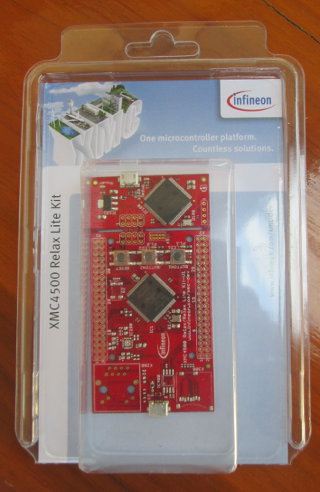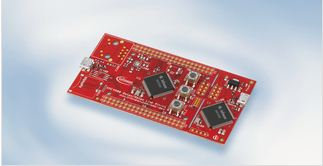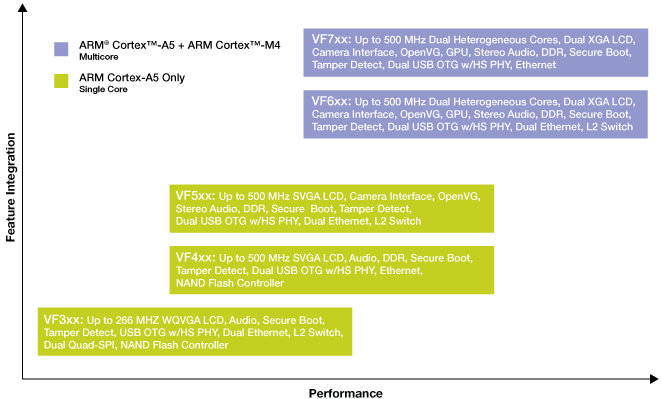Infineon Relax Lite Kit is a 10 Euros development kit based on Infineon XMC4500 Cortex M4 MCU with 160 KB SRAM and 1 MB flash, and featuring 2 USB OTG ports for debugging and powering up the board, 3 buttons (including reset), 2 LEDs, and 2 headers (through holes) giving access to the signals from the MCU such SPI, I2C, I2S, UART, CAN, ADC, DAC and PMW. The kit if available online via Hitec, but unless you live in Germany, this is not an interesting option, as international shipping costs over 100 Euros. So you’d better check local distributors in your country. The package only comes with the board, and you’ll need a USB to microUSB to power the board. To get started, simply connect the board via the USB cable to one of the USB OTG connectors, and to a Windows PC. The power LED (green) should lit up, […]
Infineon Unveils Low Cost XMC4500 Relax & Relax Lite Kits For Cortex M4 XMC4500 MCUs
Infineon XMC4500 micro-controller family is based on ARM Cortex-M4 core @ 120 MHz, comes with 128 to 160 KB SRAM, 512 KB to 1 MB “Program Memory” as well as interfaces & peripherals, such as DMA, Ethernet, USB, ADC, DAC, SPI, I2C, I2S, UART and more. They are specifically designed for industrial applications supporting temperatures up to 125°C. The family was announced at Embedded World 2012 in February, and mass production started in May. This week at Electronica 2012, the company announced two low cost development kits for XMC4500 MCU: XMC4500 Relax Lite Kit (10 Euros): XMC4500 Microcontroller (ARM® Cortex™-M4F based) Detachable on-board debugger Power over USB ESD and reverse current protection 2 x user button and 2 x user LED 4 x SPI-Master, 3x I2C, 3 x I2S, 3 x UART, 2 x CAN, 17 x ADC (12 bit), 2 x DAC, 31x PMW mapped on 2 Pin Headers […]
uClinux on Cortex-M3/M4 MCU: The Costs, Performance and Power Consumption
I previously wrote about different options available to run Linux on Cortex M3 & M4 Microcontrollers, and more recently Vladimir Khusainov, co-founder and Director of Engineering at Emcraft Systems,wrote a longish article entitled “Practical Advice on Running uClinux on Cortex-M3/M4” on electronicdesign.com, where he explains how SoM are usually selected, the costs of running uClinux on Cortex M3/M4 MCUs such as Freescale K70 or STmicroelectronics STM32F2/F4, as well as performance and power consumption considerations. First, Vladimir addresses one comment that says there’s basically no use for uClinux on Cortex M3/M4 MCU, since external memory is needed and an ARM7/ARM9 modules (with MMU) can be purchased for almost the same price. There are 2 counter arguments to this point of view: In practice, customers usually select an hardware platform first, then think what OS can be used on the platform. For example, if a company decided to use an hardware based […]
Motomic Butterfly Media Grid Renders Pictures and Videos on Freescale Kinetis K70 Cortex-M4 MCU
Motomic has officially announced Butterfly Media Grid, the first media player for Cortex M4 micro-controllers. The software currently runs on Freescale MQX Real-Time Operating System, and can display pictures and logos, as well as play videos on micro-controllers such as the Freescale Kinetis K70 MCU. Here are Media Grid key features: Display images, logos and videos Configure from full screen to grids up to 10×10 Rotate content Configure to optimize performance Display at resolutions up to HD Update over a network. Media Grid is available as a standalone application, and an SDK is also provided in order to embed the technology in custom applications using C, C++ or Qt interfaces. Since the media can be updated over the network, Media Grid is actually similar to a simple digital signage player for low end hardware. Motomic showcased the Media Grid at Design West, in March 2012, and only recently uploaded a […]
IAR Systems Releases Embedded Workbench for ARM Version 6.40
Earlier today, IAR Systems has announced the release of version 6.40 of Embedded Workbench for ARM. This new version introduces several new features, enhancements and optimizations. The enhancements include a new source browser and text editor, with functionality such as auto-completion, code folding, block selection, block indentation, bracket matching, and zooming. Word/paragraph navigation have also been improved. IAR Systems also enhanced the compiler with improvements to the stack usage analysis functionality that provides calculations of the maximum stack depth for each call graph root and new features such as support for C++ source code and recursion. A new linker directive check can be used to calculate the stack usage at link time to verify that the used stack space does not exceed the allocated memory. The inline assembler has also been improved and expanded with a large number of new operand constraints and modifiers. In a previous post “Green Hills […]
VWorks VLAB Powers Freescale Vybrid Virtual Platform
Back in March, Freescale announced their Vybrid solution featuring both a Cortex A5 processor and a Cortex M4 microcontroller, and they had prototypes running an unnamed virtual platform in order to speed up software development and possibly have the software ready at the same time as the silicon is. Always looking to learn more, I studied and wrote about virtual hardware platforms such as Cadence Virtual System Platform, Wind River Simics Virtual Platforms and the open source Imperas OVPsim simulator. It turns out Freescale does not use any of these solutions, but relies on VWorks VLAB instead, which still use the same standard (SystemC/TLM) as the virtual hardware solutions aforementioned. VWorks uploaded a demonstration of VLAB running a virtual platform for the Freescale Vybrid controller and showing how it can handle both ARM Cortex-A5 and Cortex-M4 cores. This demo of VLAB 1.7.0 is pretty interesting and showcases: Dual (virtual) display […]
Emcraft Open Sources uCLinux and U-boot for Cortex M3 and M4 MCUs
Emcraft Systems has open sourced its ports of U-Boot and uClinux for Cortex-M3 and Cortex-M4 which are available on github at https://github.com/EmcraftSystems. This release supports the following platforms: ST Micro STM32F2 NXP LPC17XX Actel SmartFusion Freescale Kinetis You can check the source code as follows: uCLinux: git clone git://github.com/EmcraftSystems/linux-emcraft.git U-boot: git clone git://github.com/EmcraftSystems/u-boot.git The company has also designed systems on module (SoM) with enough memory to run Linux with Cortex M3/M4 micro-controllers: Freescale Kinetis K70 SOM Actec SmartFusion SOM ST Micro STM32 SOM You might find more details on building/using u-boot or uClinux on EmCraft documentation page (especially linux-cortexm-um-1.4.1.pdf) and you may want to check EmCraft website for details on available hardware and BSP for Cortex M3/M4 solutions. Jean-Luc Aufranc (CNXSoft)Jean-Luc started CNX Software in 2010 as a part-time endeavor, before quitting his job as a software engineering manager, and starting to write daily news, and reviews full time later […]
Freescale Vybrid Controllers: Cortex A5 + Cortex M4 Solutions
Freescale announced the new Vybrid platform based on Cortex A5 application processor and Cortex-M4 MCU (VF6xx and VF7xx family only) which targets building/home automation and control, industrial automation, point-of-sale systems, medical devices, smart energy equipment, and appliances. There are 5 families of Vybrid Controllers which support the following common features: Video/Camera Interface Unit + optional OpenVG GPU (except VF3xx) Up to 800 MHz data rate DDR3 and LPDDR2 support (except VF3xx) USB 2.0 OTF with Integrated PHY (1 or 2 depending on model) Ethernet 10/100 MAC (1 or 2 depending on model) Display controller (WQVGA to XGA resolutions) High-assurance boot with Crypto Acceleration Up to 1.5 MB on chip SRAM NAND Flash controller and Dual Quad-SPI with eXecute-In-Place(XIP) Dual 12-bit ADC and DAC Here are the 5 families of Vybrid platforms and key differentiating features: VF3xx: ARM Cortex-A5 up to 266 MHz, 1x USB 2.0 OTG, 2x Ethernet, display up […]







